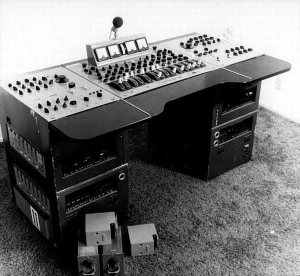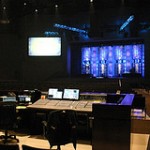
A Day in the Life of Fundamentals

So my Beatles book finally arrived last week. I am a kid in a candy store. It’s actually divided into 4 sections. Section 4 is about the actual production, but the first three sections(342 pages) are all about Abbey Road and the equipment used. The detail is freakish. The only thing that could top this book is if I could walk through the studios and talk with the engineers. Going through this book has got me thinking about some things.
The photo here is of an EMI REDD.37 console which was the same type of console the Beatles recorded their first album and much of their second with. They also used a console very similar to this, the EMI REDD.51, but I couldn’t find any photos of that one.
The REDD.51 is where we most likely get the term “plugin” as there was no built-in EQ on the console. Instead there were EQ Plugins that the engineer could use, and there were a couple types he could choose. The plugins literally “plugged” into the console for use. The interesting thing about these EQ plugins is that they were very limited in what they could do. They only had a boost and cut for treble and bass on each channel. No mid frequencies. No sweepable parametric. Treble. Bass. That’s all. The “Classic” EQ plugin bass and treble were shelfs at 100 Hz and 10 kHz. The Beatles typically used the “Pop” EQ plugin which had bass control identical to the “Classic”. The treble control, however, was a shelving EQ centered at 10 kHz when cutting, but a peak EQ centered at 5 kHz when boosting. This type of EQ is the same as the Pultec used in the states.
Can you imagine if all you had on your console EQ was a 100 Hz shelf and a 10 kHz shelf? It’s hard for me to imagine what I would do if that was all I had to work with a vocal. Yet, those records all sound great. Of course the equipment the Beatles had was still amazing despite any limitations, but I think the quality of those records was more a testament to the time and focus put on getting great sounds before the tape rolled. There are a lot of toys in the audio world these days, but at the end of the day it still always comes back to fundamentals of mic placement, talented musicians, and great songs and arrangements.

 Next Post
Next Post



I love the idea of a 2 band EQ. It would definitely make you work harder at having everything sounding right before you ever roll tape. It seems more and more today that anyone thinks they can “fix it in the mix”. Instead taking a little extra time and effort and ears to make it right before it gets to the mix. Mic selection included. I think this is pretty valuable for live sound as well.
I’ve appreciated this about you and your blog. I see you purposeful for that kind of excellence.
One of our worship team drummers is a HUGE Beatles fan and has this same book. He actually had a chance to go to Abbey Road this Fall and take a tour and spend some time in a session. I believe he said Oasis was recording at the time(don’t quote me…not positive). He also said that all the hallways were lined with gear and tape machines. When he asked about it, the manager said they had done there best to never get rid of a piece of gear and to make sure that everything always worked in some capacity.
Oh to be able to spend a couple days there and play…I am salivating!
Well, given the right tools in skilled hands, there is definitely an amount of “fixing” that can be done.
But, I also look at it this way: A little band-aid on a minor cut might not be so noticeable, but it’s not so easy to hide bandages on a trauma victim….
I agree that a ton can be done. I just have a soft spot for thinking it through up front.
“A little band-aid on a minor cut might not be so noticeable, but it’s not so easy to hide bandages on a trauma victim….”
That’s hilarious! I just got through watching American Idol and I think that this might apply there as well 🙂
I think the Beatles recordings sound so good is
because most of the equipment (pre-1968) contained vacuum
tubes, the great acoustics of Studio one and two and the
sheer inventiveness of Norman Smith, Geoff Emerick and
Sir George Martin
But what’s funny is a lot of the engineers back then weren’t satisfied with the equipment because it colored things so much. They knew the sounds they had in the studio would never be heard on playback, and that frustrated them. BUT then as the technology got cleaner and cleaner everybody wanted that sound back. Go figure.
i’ve always tried to get most of my sounds with decent mics, mic placement, etc., but lately ‘ve been finding myself getting drawn into the trap of immediately eq-ing and compressing, etc. every track i record, just because the means are there. i’m starting to make myself sick. i think i need an intervention…
shame to think a lot of the bulkier vintage gear would of been landfilled.
abbey rd had a big clear out in the early 90s..sold stuff dumped stuff.
everyone was embracing digital including george martin at air studios.
it wasn’t until bands like oasis embraced analogue again that abbey rd started buying back some of the vintage equipment they had got rid of.
the BBC were the worst offenders.
from the 70s through to the 90s i remember seeing skips full of vintage studio sound equipment.i remember one engineer saying to me,you know thats a nice bit of kit.but we have been told to upgrade.
i have filmed in abbey rd,quite a few times amazing place.it is true the corridors are packed with gear,have accidentally hit b&w nautilus speakers many a time.